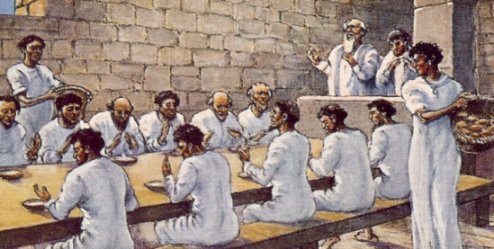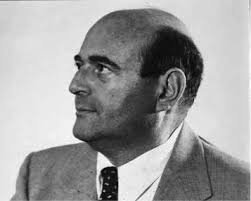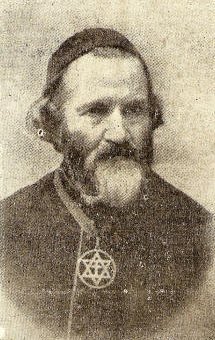|
 An ancient sect of the Essenes at the meal table, Qumran
An ancient sect of the Essenes at the meal table, Qumran
A. The Historical Essenes
The historical Essenes (Gk. Essénoi, Essaioi, Össaioi, plural of 'asé, 'asyá, meaning 'healer'; cp. Philo's Therapeutai), as opposed to those Gnostics and New Agers calling themselves 'Essene Christians' today, were a Jewish religious community which flourished in the 1st century BC and 1st century AD, and are the third of the Jewish 'philosophies' or schools of thought enumerated by Josephus (BJ 2.8.2-13; cp. Antiquities 18.1.5). Apart from Josephus, we have two accounts of them from his older Jewish contemporary Philo of Alexandria (Quod omnis probus 75-91); Hypothetica ap. Eusebius., Praep.Ev. 8,2) and one from the elder Pliny (Nat.Hist. 5.17). A later account in Hippolytus (Refut. 9.20.12-13) follows Josephus in the main, but includes some information apparently derived from independent sources.
Philo's description of the Essenes is intended to illustrate his thesis that only the truly good man is truly free. He estimates their numbers at about 4,000, and tells how they live in villages, working hard at agriculture and similar pursuits, devoting much time to the communal study of moral and religious questions, including the interpretation of the sacred books. They pay scrupulous attention to ceremonial purity, he says; they hold all their property in common, abstain from animal sacrifice, practice celibacy, keep no slaves, make provision for those of their number who are prevented from working by sickness and old age, swear no oaths, take no part in military or commercial activity, and in general cultivate all the virtues.
Pliny's account comes in the course of his descriptions of the Dead Sea. He describes the Essenes as living on its west side, above En-gedi. They have lived there for countless generations, he says, renouncing both women and money; yet their numbers have been continually maintained, because so many regularly come to join their solitary existence through sheer weariness of ordinary life. Pliny writes between AD 73 and 79, but he is probably dependent for his knowledge of the Essenes on earlier writers, such as Alexander Polyhistor (1st century BC).
The accounts in Philo and Pliny are idealised and marked by rhetorical exaggeration. Those in Josephus (when all due allowances are made for this author's tendency to modify historical truth for his private ends) strike one as being factual and based on first-hand knowledge. According to Josephus, the Essenes were to be found in all the cities of Judea, including Jerusalem. They practiced hospitality. An Essene from a distance would be treated as a brother by any fellow-Essene to whose house he came. But much of Josephus' description implies a community life such as could not be followed by city-dwellers. It is likely that the fully initiated Essenes lived in separate communities, while they had attached to their order associate members who lived in cities and followed the ordinary ways of life.
Josephus gives us a fairtly detailed account of the Essenes' initiation procedure. This involved a three years' novitiate. At the end of the first year the novice (who had already worn the white habit of the order) was admitted to the ritual purification in water, but two further years had to elapse before he was admitted to share the common meal. This was evidently the token of full membership. Before finally passing from the novitiate to full membership the candidate was required to swear a succession of solemn oaths.
This account bears a general resemblance to the rules of admission to the Qumran community as detailed in 1QS, although it differs in a number of particulars. For example, 1QS lays down a novitiate of two years, not three.
The Essene's day, according to Josephus, began before sunrise with morning prayers, addressed to the sun "as though entreating him to rise". Then he betook himself to his allotted task, under the direction of his overseer, and worked at it until noon. At noon the members bathed and partook of a simple meal in common. They then resumed their working clothes and continued at their appointed tasks till evening, when they assembled for another meal.
Hippolytus has nothing to say about the Essenes' morning address to the sun: according to him "they continue in prayer from early dawn and speak no word until they have sung a hymn of praise to God". The practice described by Josephus may have been that of the Sampsaeans, a group perhaps associated with the Essenes, who acquired their name (cp. Heb. shemesh, 'sun') from acts of homage paid to the sun as a manifestation of divinity. The term 'Essenes', in fact, was used at times to cover a fairly wide range of Jewish sectarian bodies that drew aside from the main stream of Jewish life. One of these, almost certainly, was the Qumran community. There may have been several more of which we know as little as we knew of the Qumran community before the discoveries of 1947 and the following years (see Dead Sea Scrolls).
Though controversy remains, it is fairly well established now that the Qumran community was a community of Essenes (perhaps of those Essenes whom Josephus distinguishes from the rest because they did not always abstain from marriage), the Qumran literature must take its place above all other accounts of the Essenes which have come down to us from antiquity because it comes from within the Essene ranks.
 A modern Essene sect assembled for meditation and instruction
A modern Essene sect assembled for meditation and instruction
B. Modern 'Christian' Essenes
Modern 'Christian' Essenism, which consists of many diverse groups, is a form of Gnosticism with little or no connection to the historical Essenism of Qumran. Unlike the historical Essenes who were founded on the canon of the Tanakh (Old Testament), minus the Book of Esther, the 'Christian' Essenes have their own assortment of Gnostic-type scriptures that similarly exclude the historical Messianic Scriptures (New Testament), many of which, if not most, are fakes. These include the best known Essene Gospel of John (also known as The Gospel of Peace of Jesus Christ and The Essene Gospel of John), a mutilated look-alike of the Gospel of John and The Gospel of the Holy Twelve (also called The Gospel of the Perfect life). All promote vegetarianism, revile and repudiate the Tanakh (Old Testament), and in particular animal sacrifices (accusing Ezra of forging most of the Tanakh), promote reincarnation and teach a gospel of salvation by knowledge and works (gnosticism). According to the Gospel of the Holy Twelve, the majority of apostles were not fishermen but lemon-pickers.
 The modern movement traces back to Edmund Bordeaux Szekely (see right), a Hungarian philologist/linguist, philosopher, psychologist and natural living experimenter. His grandfather was Sándor Székely, poet and Unitarian Bishop of Kolozsvár (Klausenburg), his mother was a French Roman Catholic, and his father was a Hungarian Unitarian. He was a descendant of Hungarian philologist and orientologist Sándor Korösi Csoma. Szekely received a doctorate from the University of Paris, and other degrees from the universities of Vienna and Leipzig. He held professorships in philosophy and in experimental psychology at the Bolyai University in Kolozsvár (now Cluj in Romania).
The modern movement traces back to Edmund Bordeaux Szekely (see right), a Hungarian philologist/linguist, philosopher, psychologist and natural living experimenter. His grandfather was Sándor Székely, poet and Unitarian Bishop of Kolozsvár (Klausenburg), his mother was a French Roman Catholic, and his father was a Hungarian Unitarian. He was a descendant of Hungarian philologist and orientologist Sándor Korösi Csoma. Szekely received a doctorate from the University of Paris, and other degrees from the universities of Vienna and Leipzig. He held professorships in philosophy and in experimental psychology at the Bolyai University in Kolozsvár (now Cluj in Romania).
Szekely claimed to have found an Aramaic translation of The Essene Gospel of Peace and The Essene Book of Revelation at the Vatican library. In the scriptorium of the Benedictine monastery of Monte Cassino he claimed to have found the original Hebrew text of The Essene Gospel of Peace. He later said that he recognised several fragments in these that were either similar, or identical, to various passages from the Old and New Testaments, the Dead Sea Scrolls, and the Avesta (the scriptures of the Zoroastrians). While Szekely's claimed translations of the so-called 'Essene Texts' have drawn interest from followers of various faiths, mostly New Agers and liberal Christians, the original manuscripts have never been located, and are considered forgeries by most scholars.
When University of Lund theologian Per Beskow investigated Szekely's claims in Strange Tales About Jesus, both the Vatican and the National Library of Vienna denied that any original manuscripts existed. The Vatican also denied that Szekely had ever been admitted to the Vatican Archives in 1923, as he claimed. The third claimed manuscript source was the library at Monte Cassino, which was destroyed during World War II.
 The Gospel of the Holy Twelve is the creation of an earlier forger, Rev. Gideon Jasper Richard Ouseley (1834–1906) (see right), who published his work in 1901. It is a reworking of the King James Version's four Gospels-in-one. A detailed exposé and revelation may be found below. Ousley, like Szekely, claimed access to ancient manuscripts, this time from Tibet, though these have never been proven to exist. Later editors of this work changed the story and claimed that Ouseley channelled this work in 'dreams' and 'visions'. The work remains unrecognised by academic Biblical scholars and has been rightly dismissed by both modern theologians as well as historians of the animal rights movement and vegetarians in general.
The Gospel of the Holy Twelve is the creation of an earlier forger, Rev. Gideon Jasper Richard Ouseley (1834–1906) (see right), who published his work in 1901. It is a reworking of the King James Version's four Gospels-in-one. A detailed exposé and revelation may be found below. Ousley, like Szekely, claimed access to ancient manuscripts, this time from Tibet, though these have never been proven to exist. Later editors of this work changed the story and claimed that Ouseley channelled this work in 'dreams' and 'visions'. The work remains unrecognised by academic Biblical scholars and has been rightly dismissed by both modern theologians as well as historians of the animal rights movement and vegetarians in general.
Though it is hard to establish what Ouseley's motives were, there is no doubt that Szekely's were the promotion of vegetarianism and a healthy lifestyle in general, as evidenced by his formation of the International Biogenic Society and the establishment of a camp with an organic garden named Rancho la Puerta in Baja California. But why would anyone want to fabricate a gospel to prove that Yah'shua (Jesus) was a vegetarian, or anything else about Yah'shua (Jesus)?
There is plenty of solid historical evidence that the message of Yah'shua (Jesus) included simple living and nonviolence, though there is no evidence that He ever promoted vegetarianism, even if the poverty of the age meant that most people of the time would have only eaten meat on rare occasions (such as at the Feasts). He Himself is known to have encouraged fishing, to have eaten fish Himself, and must have eaten roast lamb at Passover as prescribed by the Torah (Law).
Of Szekely's 10 credal statements for his Biogenic Society, only one was religious, namely, a belief in the "fatherhood of God, the Motherhood of Nature, and the Brotherhood of Man". The lifestyle consisted of meditation, simple living, and respect for the earth in all its forms, with no evidence of any religion remotely resembling that of the Bible. Like the anonymous author of the contemporary Jewish kabbalistic 5-volume Encyclopedia of Forbidden Knowledge, the motives of both Szekely and Ouseley seem to have been anti-blood atonement. Since the salvific efficacy of blood lies at the very heart of both the Old and New Testaments, the proponents of 'Christian' Essenism represent a dangerous anti-Messiah (antichrist) position, even if their goal of healthy living is admirable and not at all incompatible with the true Besorah (Gospel) of Yah'shua the Messiah (Jesus Christ).
The hostility by many churches toward vegetarians and vegans may in part explain why these men felt the need to forge gospels justifying it. The need for animal sacrifices ended with the cross. Aside from the annual Passover meal in the spring, there is no requirement to eat meat at all. In the Messianic Evangelical tradition, those who do eat meat are counselled to do so in moderation, particularly red meat, and it is recognised that our first parents were, before the Fall, fruitarians and that one day true believers will one day return to this state. Messianic Evangelicals are animal-lovers. It is the position of NCAY to encourage believers to a healthy lifestyle as their conscience leads them, not imposing their diet on anyone else provided it conforms with Yahweh's kashrut laws.
The worst possible thing that a vegan or vegetarian could ever do is turn to a false Gnostic 'gospel' (and there are many of them - more recently, in the 1980's, The Humane Gospel of Jesus appeared offering a similar régimen) to justify their eating habits and so risk losing their salvation, or never acquiring it in the first place. Gnosticism does not save. It damns. Therefore we have to say, unequivocably, that whilst we respect and approve of most of 'Christian' Essenism's healthy living practices, we must utterly reject their Gnosticism. What matters in the end is whether you are heaven- or hell-bound and that is not determined by diet but by trusting in the saving blood of Yah'shua the Messiah (Jesus Christ).
|


